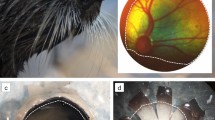Abstract
The relatively large eye and pupil of the Piked Dogfish, Squalus acanthias, is visually arresting. However, knowledge of its basic visual characteristics lags far behind other areas in this generally well studied species. This study quantifies pupil dilation in a species that is naturally exposed to a broad range of light intensities and finds that the pupil area in the dark adapted state is 35.3% of the total eye area, an increase of 12.4% from the light adapted state. The anterior and posterior extents of the horizontal visual field are assessed and compared with both morphological and electrophysiological techniques and the results are integrated with the measured head yaw to derive the anterior convergence distance and blind area. The position of the eyes and the triangular, pointed snout of S. acanthias provides excellent anterior vision, which likely facilitates foraging upon its mobile prey.



Similar content being viewed by others
References
Binns A, Margrain TH (2006) Development of a technique for recording the focal rod ERG. Opthal Physiol Opt 26:71–79
Bozzano A (2004) Retinal specializations in the dogfish Centroscymnus coelolepis from the Mediterranean deep-sea. Sci Mar 68(Suppl 3):185–195
Bozzano A, Murgia R, Vallerga S, Hirano J, Archer S (2001) The photoreceptor system in the retinae of two dogfishes, Scyliorhinus canicula and Galeus melastomus: possible relationship with depth distribution and predatory lifestyle. J Fish Biol 59:1258–1278
Castro JI (1983) The sharks of North American waters. Texas A&M University Press, College Station
Compagno LJV (1984) FAO species catalogue. Vol. 4. Sharks of the world. An annotated and illustrated catalogue of shark species known to date. Part 1—Hexanchiformes to Lamniformes
Compagno LJV, Dando M, Fowler S (2005) Sharks of the world. Princeton University Press, Princeton
Cornett AD (2006) Ecomorphology of shark electroreceptors. Unpublished MS thesis, Florida Atlantic University, 110pp
Crescitelli F (1991) Adaptation of visual pigments to the photic environment of the deep sea. J Exp Zool Suppl 5:66–75
Franz V (1931) Die akkomodation des selachierauges und seine abblendungsapparate, nebst befunden an der retina. Zool J Abt Allgem Zool 49:323–462
Gruber SH (1967) A behavioral measurement of dark-adaptation in the lemon shark, Negaprion brevirostris. In: Gilbert PW, Mathewson RF, Rall DP (eds) Sharks, skates and rays. Johns Hopkins Press, Baltimore
Harris AJ (1965) Eye movements of the dogfish Squalus acanthias L. J Exp Biol 43:107–130
Hueter RE (1991) Adaptations for spatial vision in sharks. J Exp Zool Suppl 5:130–141
Hueter RE, Gruber SH (1982) Recent advances in the studies of the visual system of the juvenile lemon shark (Negaprion brevirostris). Fla Sci 45:11–24
Kajiura SM (2003) Electroreception in neonatal bonnethead sharks, Sphyrna tiburo. Mar Biol 143:603–611
Kajiura SM, Holland KN (2002) Electroreception in juvenile scalloped hammerhead and sandbar sharks. J Exp Biol 205(23):3609–3621
Kuchnow KP (1970) Threshold and action spectrum of the elasmobranch pupillary response. Vis Res 10:955–964
Kuchnow KP (1971) Elasmobranch pupillary response. Vis Res 11(12):1395–1405
Lisney TJ, Collin SP (2007) Relative eye size in elasmobranchs. Brain Behav Evol 69:266–279
Litherland L, Collin SP (2008) Comparative visual function in elasmobranchs: spatial arrangement and ecological correlates of photoreceptor and ganglion cell distributions. Vis Neurosci 25:549–561
McComb DM, Kajiura SM (2008) Visual fields of four batoid fishes: a comparative study. J Exp Biol 211:482–490
McComb DM, Tricas TC, Kajiura SM (2009) Enhanced visual fields in hammerhead sharks. J Exp Biol 212:4010–4018
McComb DM, Frank TM, Hueter RE, Kajiura SM (2010) Temporal resolution and spectral sensitivity of the visual system of three coastal shark species from different light environments. Physiol Biochem Zool 83:299–307
Mora-Ferrer C, Behrend K (2004) Dopaminergic modulation of photopic temporal transfer properties in goldfish retina investigated with the ERG. Vis Res 44:2067–2081
Murphy CJ, Howland HC (1991) The functional significance of crescent-shaped pupils and multiple pupillary apertures. J Exp Zool Suppl 5:22–28
Myrberg AA (1991) Distinctive markings of sharks: ethological considerations of visual function. J Exp Zool Suppl 5:156–166
Pirenne MH (1962) Directional sensitivity of the rods and cones. In: Davidson H (ed) The eye, vol 2. Academic, New York
Sivak JG (1982) Optical characteristics of the eye of the flounder. J Comp Physiol 146:345–349
Scott WB, Scott MG (1988) Atlantic fishes of Canada. University of Toronto Press, Toronto
Stell WK (1972) The structure and morphological relations of rods and cones in the retina of the spiny dogfish, Squalus. Comp Biochem Physiol 42A:141–151
van Roessel P, Palacios AG, Goldsmith TH (1999) Activity of long-wavelength cones under scotopic conditions in the cyprinid fish Danio aequipinnatus. J Comp Physiol 181:493–500
Warrant EJ (2000) The eyes of deep-sea fishes and the changing nature of visual scenes with depth. Philos Trans R Soc Lond B 355:1155–1159
Warrant EJ, Locket NA (2004) Vision in the deep sea. Biol Rev 79:671–712
Young JZ (1933) Comparative studies on the physiology of the iris. I. Selachians. Proc R Soc Lond (B) 103:228–241
Acknowledgements
This work was conducted at the Mt. Desert Island Biological Laboratory through a Salisbury Cove Fund new investigator award with additional support from the Florida Atlantic University Department of Biological Sciences and the National Science Foundation (IOS-0639949). I am grateful to C. Wray, M. Bailey and S. Tallack for assistance at MDIBL and to the members of the FAU Elasmobranch Research Laboratory for logistical support.
Author information
Authors and Affiliations
Corresponding author
Rights and permissions
About this article
Cite this article
Kajiura, S.M. Pupil dilation and visual field in the piked dogfish, Squalus acanthias . Environ Biol Fish 88, 133–141 (2010). https://doi.org/10.1007/s10641-010-9623-z
Received:
Accepted:
Published:
Issue Date:
DOI: https://doi.org/10.1007/s10641-010-9623-z




